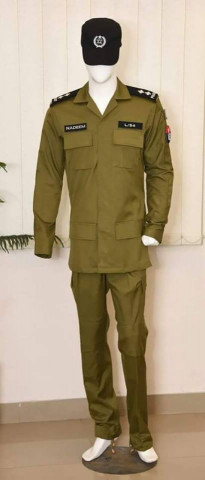The man behind the uniform
The uniform of the Punjab police has undergone a change of colours

New uniforms of the Punjab Police. PHOTO: PUNJAB POLICE
Security is the number one problem of the country. Terrorism, targeted killing and crimes have disabled cities that have great commercial and socio-cultural potential. Karachi for years has been performing under par on its market potential. Peshawar has been the first stopover for terrorists hopping across the border. Lahore that used to be an example of socio-cultural festivity was turned into a fortress to host a literary festival and to hold the PSL final. The effort to return to normality with a beefed up force is commendable but the fact that it takes a huge national effort mainly dependent on our armed forces is what makes these one-time events unsustainable. It is a given that the governance of a country or a province cannot improve till its police becomes capable of restoring order on a daily basis. This perhaps has been the key failure in ensuring citizen safety, investment security and peace in the country. It is easy to target the police as an institution for this failure but the fault lies more so on those who are responsible for creating an enabling environment for the police to flourish as an effective state organ.
Take, for example, the system under which the police in three of the four provinces is governed. It is the same colonial system of 1861. This is not just old, or antique, but medieval. Why the system has not changed is because the purpose of the colonial times governors is also the purpose of present time chief ministers — that is to hoard power in their hands and lord over the rule of law. The police ordinance 2002 of Musharraf era has gathered dust and the recent police ordinance 2016 is only enforced in K-P. A system that is 155 years old can only do one thing and that is to drag the performance of this vital state institution down to embarrassing levels. Meritocracy is absolutely limited to those who serve the man who heads the province /capital rather than who serves the public. Consider the latest feud in Sindh. The present or ex IG Sindh A D Khawaja, depending on what happens when this article is published, has been serving on a revolving door basis in the Sindh government. In December 2016 he was asked to go on forced leave but was restored by the federal government as 35 former IGs wrote to the prime minister to vouch for his integrity and competence. Since then it has been a musical chair game with the latest IG chair contestant being Sardar Majeed Dasti.
This crude and open fight between the powers of the government and powers of the court is a self-explanatory example of law twisting in the provinces. According to some reports, Khawaja’s refusal to appoint loyalists of the Sindh government regardless of merit has resulted in this ugly brawl. One heartening feature in this case is that the civil society has come out in his defence and have filed a case in the Sindh High Court and succeeded in getting a restoration order for A D Khawaja and the removal of Dasti. With this, chaos at the top the police department must be in total uncertainty and disarray, where instead of focusing on fighting the criminals they must be fighting for their own survival.
The main ploy in this century and half old system governing the provinces is that it gives the power of postings, transfers and promotions in the hands of the man who appoints the man to head police. In the last nine years 14 IGs have been transferred/posted in Sindh which makes their average tenure of hardly eight months. It is almost a norm now that at least 50% of the job occupation of the people working in this department is spent on getting themselves in the right slots and the right cities through the right signing authorities. Just have a look at the recent judgment of the Lahore High Court on out of turn promotions in the Punjab police.
The Supreme Court ordered that 121 senior Punjab police officers who had received out of turn promotions in violation of the constitutional process have to be demoted. This number may seem small in comparison to the total police force but just imagine that each one of them heads units or teams of hundreds of officers who in turn may have been hired or promoted not on performance but on adherence to the orders above? It just takes one wrong appointee to destroy the culture and devastate performance of an entire team.
In a recent internal assessment report of the Punjab police, the performance of 10 divisions of Punjab, between January and November this year, each headed by a regional police officer (RPO), as reviewed by the IG of Police Operation Punjab was declared “Poor”.
Changing the paint of the building but not strengthening its foundation will result in regular cracks on the structure as soon as pressure builds up. The strategy to make surface changes without changing the real DNA of the system will result in performance cracks. Another example of this approach is the recent PIA reform and restructuring plan. The plan presented to the government claims to have made the “massive” change of designations and titles. The nine divisions which were headed by “directors” will have the new designation of “chief”. Thus the director technical is now chief technical officer, the director human resource is now chief human resource officer and so on and so forth.
Change in name, title, uniform, colour is a tested, tried and failed strategy of those who sell counterfeit products in the market. The obsession with focusing on “appearances” and not on the person inside is what has made the institutions become not only the centre of satires in the media but the object of ire in the highest courts too. No amount of dressing up of the uniform will compensate for the fatal dressing down of merit, of quality, of accountability and of integrity.
Published in The Express Tribune, April 9th, 2017.
Like Opinion & Editorial on Facebook, follow @ETOpEd on Twitter to receive all updates on all our daily pieces.


















COMMENTS
Comments are moderated and generally will be posted if they are on-topic and not abusive.
For more information, please see our Comments FAQ